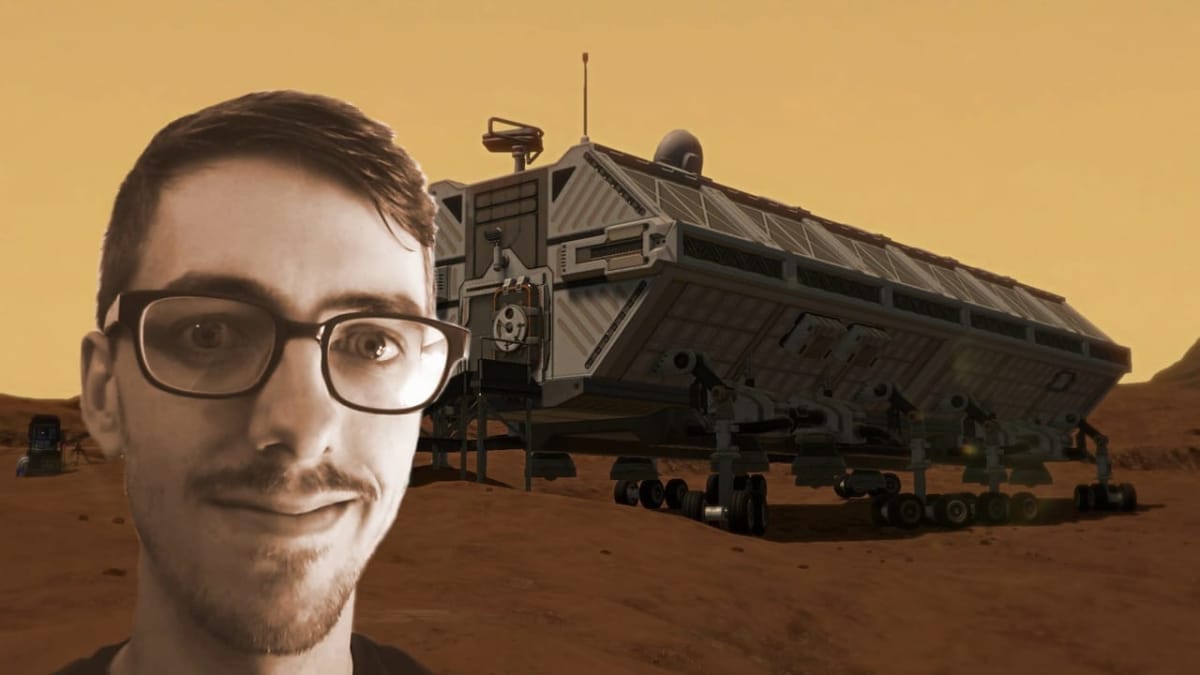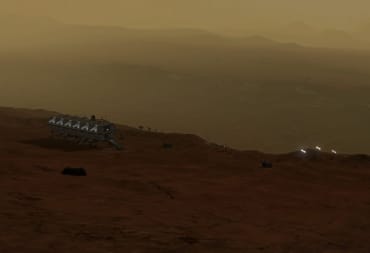I recently had the pleasure of previewing Lacuna Passage, an upcoming game by Random Seed Games where players take on the role of a lone survivor on Mars just trying to stay alive. When I got my hands on the game, I played it for nine hours straight. Suffice to say, I liked it.
Now, I can't call myself an expert on space stuff. I couldn't name all of the rovers and landers on Mars right now. I couldn't tell you what big missions are coming up. What I can say is that I like space games and space movies. I really enjoyed The Martian (the book and the movie, both of which I've been through an uncomfortable number of times). I really like Planetbase, a game that's all about surviving and building a colony on other worlds. I grew up watching every Star Trek save for the original series (which was a bit before my time), and I've seen all the movies. I'll happily concede that I'm no expert, but suffice to say I'm an enthusiast.
During the gameplay that would lead to my preview of Lacuna Passage, I took meticulous notes. Anytime a bug cropped up or I encountered something that made me go "Hmmm," I wrote it down. Bugs were handled (and many of the things I've reported have since been fixed in patches), but I still had quite a few lingering questions. A week after I put the game to bed (and with a bit of extra playtime somewhere in the middle, just for fun), I managed to sit down and have a chat over Skype with Tyler Owen of Random Seed Games about Lacuna Passage. Have yourself a peek at the recently-released Early Access trailer to get a feel for the game:
https://www.youtube.com/watch?v=XbMXvPBOpFU
Random Seed Games
TechRaptor: Let's start with telling our readers about yourself and the rest of the team at Random Seed Games.Tyler Owen: Yeah, so, my name is Tyler Owen and I'm the main developer and founder of Random Seed Games. I started the company back a few years ago around 2010. I originally was working in smaller applications doing things like flash games and iOS games. Eventually, I worked my way up and started developing in Unity and Random Seed Games was just kind of a moniker I used for myself to publish my own small titles. After a while, I started pulling in some volunteer contributors and working on [projects that were a little bit larger] and that kind of culminated with running a Kickstarter for this game Lacuna Passage. The team kind of encompasses a lot of different people and volunteers. It's been a really interesting development process because we haven't been a full entity as far as a company with a bunch of employees. It's really just me and then I bring in outside freelance contract and occasionally part-timers. My brother [Spencer Owen] for a period of about a year-and-a-half or two years worked as a full-time artist on the project. But then we also have freelance contractors working on sound and music and other art from all over the world. [Our] composer's in Australia, and then we've got people working on sound effects in England, and other people all over the U.S. working on art. So yeah, it's a really interesting dev process 'cause we're a fully remote studio and so I just kinda work from home and put it all together myself.
TR: That's actually not all that surprising to me. A lot of indie developers are like that, like, "I'm the company and then I hire people as needed through contracts." It's relatively common until you're at the point where you're like, "We probably should have an office and put some people in it."
TO: Yeah! It's interesting how much the expansion of the indie game market has enabled that. There's just so many tools now available for developers [that makes that] a much more viable way of operating. It's working well for us so far.
TR: What led you to making a game about surviving on Mars? What were the core inspirations for it?
TO: It really was a pretty singular moment, honestly. I had some friends that I was working with at the time on some educational games for another company and we all kind of were bandying about our own ideas for titles in our off time. [This] was right around the time that the Curiosity Rover landed on Mars and I was sitting on my couch with my wife. [When] the lander was sending back its first images of Mars I turned to her and was just mentioning [what] I would give to be in that control room and be the one who was sending commands to that rover and just going where I would want it to go and take pictures of whatever I wanted to take pictures of. I realized that the closest I'd probably get to actually doing that or being on Mars myself was if I just made a game about it. And so that's what I did, I set out and started working on some prototypes and trying to figure out what a game set on Mars as an astronaut would even be. That was kind of the impetus for starting Lacuna Passage.
TR: Okay, and speaking of Lacuna Passage, is there any kind of special meaning behind the name?
TO: Yeah, [I] kind of wanted something that felt a little mysterious. It wasn't just, you know, "Mars Survival". Lacuna is a word that basically means "gap" and often it means a gap in language or knowledge. And passage obviously being a journey or going through something. I liked the idea of Mars representing this gap in our knowledge that we need to traverse. We need to get through this difficult challenge and figure some things about ourselves and about space and our place in it.
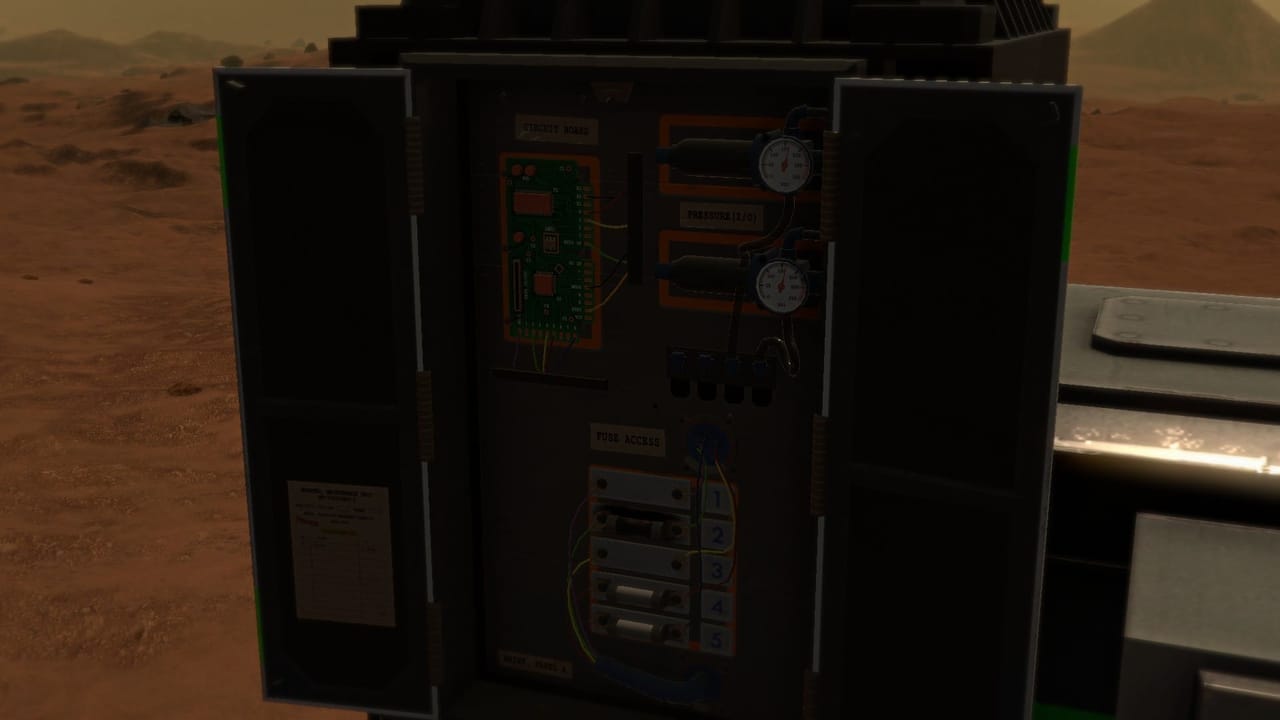
Lacuna Passage and The Martian
TR: That's really interesting. I really hate to ask this question, but I have to ask this question considering the overall theme and content of the game—only because it'll probably be on the mind of a lot of people—have you read Andy Weir's The Martian or seen the movie adaptation?TO: Absolutely, yes. And I don't hate that question at all, it's actually something that I want people to think of when they look at our game. I think that book and that movie came out at a really interesting time when collectively, as a country, we've started looking ahead to Mars again finally. You hear NASA making announcements about their plans for Mars and you hear all these other private companies talking about Mars trips. I think that the book and the movie especially really rekindled that interest in the public and kind of what would [an] astronaut deal with when exploring and doing research on Mars. The book came out right around the time we started really working on prototypes and so I immediately loved the book and really wanted to emulate the feeling that you had while reading of being an astronaut, like "These are the kinds of things that an astronaut would encounter". So I want to turn this game into that as close as possible honestly, as close as we can get to being almost a licensed version of what that is (obviously, you know, we're not Mark Watney or anything). The surviving on Mars and what would happen if your equipment broke down. What's the series of questions you'd have to ask to fix the problem? How close would you get to dying before you solved the problem?
TR: You inadvertently answered my next question because it was going to be, "If you had read it or seen the movie did anything from it work it's way into the game?"
TO: Yeah, absolutely.
TR: I think it's important to note and make it clear for our readers that ... I read the book quite a few times. It's one of the reasons why I actually decided to pick up your game [and] play it, try it out, and do this interview with you. If [someone] just looked at [Lacuna Passage at its face they might think,] "Oh, he read The Martian and that's why he made the game." But that's not necessarily what happened because all the stuff that's in [The Martian], Andy Weir based all of that stuff off of where NASA itself thinks the technology is going to be in a few years and roughly how they think a Mars mission would go. So it's not entirely out of the [question] that you [and Andy Weir] would both independently come to those same conclusions and there would be a lot of cross-over. Your game has a water reclaimer, so does The Martian. Well yeah, that's what NASA would do, they would have a water reclaimer.
TO: Right.
TR: That doesn't mean you're just pulling details right out of The Martian. That's really the core reason why I was curious about it. Aside from that lovely piece of entertainment, what kind of research went into the making of your game?
TO: I've actually got a book sitting right next to my desk constantly called The Case For Mars. It's actually a really great book that [does] a lot of what you mentioned with what kind of technologies that Andy Weir had researched to figure out what would be possible with a Mars journey right now or in the near future. The Case For Mars is a great one because it talks about the retirement of the Apollo missions and how the shuttle missions were kind of a stopgap just to keep us going into orbit. It talks about all of the different technologies that really were available even towards the end of the Apollo missions that could be utilized and adapted for a full mission to Mars and how it would actually be a lot less expensive than you'd think. It just takes the commitment [from] NASA as an organization [and] from the public and civilians as a public interest matter. But yeah, all the stuff is there and we just need to make it happen. It goes into fine detail about what kinds of things would be necessary, what it would cost, what technologies would need to be improved to make it viable for the possibility of a return mission so they're not just stuck there on Mars. There's all kinds of great books and resources online that talk about all that kind of stuff. The difficulty on our end, though, is translating the reality of a Mars mission with the playability of a Mars game. Because what is a reality for an astronaut might not be something that's necessarily fun for a player. You kind of have to create this balance of... what you're really trying to do is create a game that feels like what you would think being an astronaut would be like rather than making it as accurate of a simulation as possible where it would honestly be a pretty mind-numbing affair. There's a lot of minutiae you would have to do if that were the case.
TR: A good example is Minecraft; I'd be surprised if you weren't at least tangentially aware of it. You dig up cubic meters of dirt. If you've ever done [ditch-digging in real life] it takes a lot of time to dig up a cubic meter of dirt [as compared to] a left click in the game. So if that game were realistic, it would take you about 20 years to build a halfway-decent building.
TO: Absolutely, yeah, yeah. There's all kinds of little things that we kind of create shortcuts for or describe in a way that at least makes you understand that this is something an astronaut would have to deal with but not to the level that they would have to in real life so that you don't go crazy [and get] bored.
TR: Yeah, [you want a balance]. I noticed [there's] a degree of time compression; for example, the clock runs faster than real time.
TO: Yeah, exactly. That's a good example.
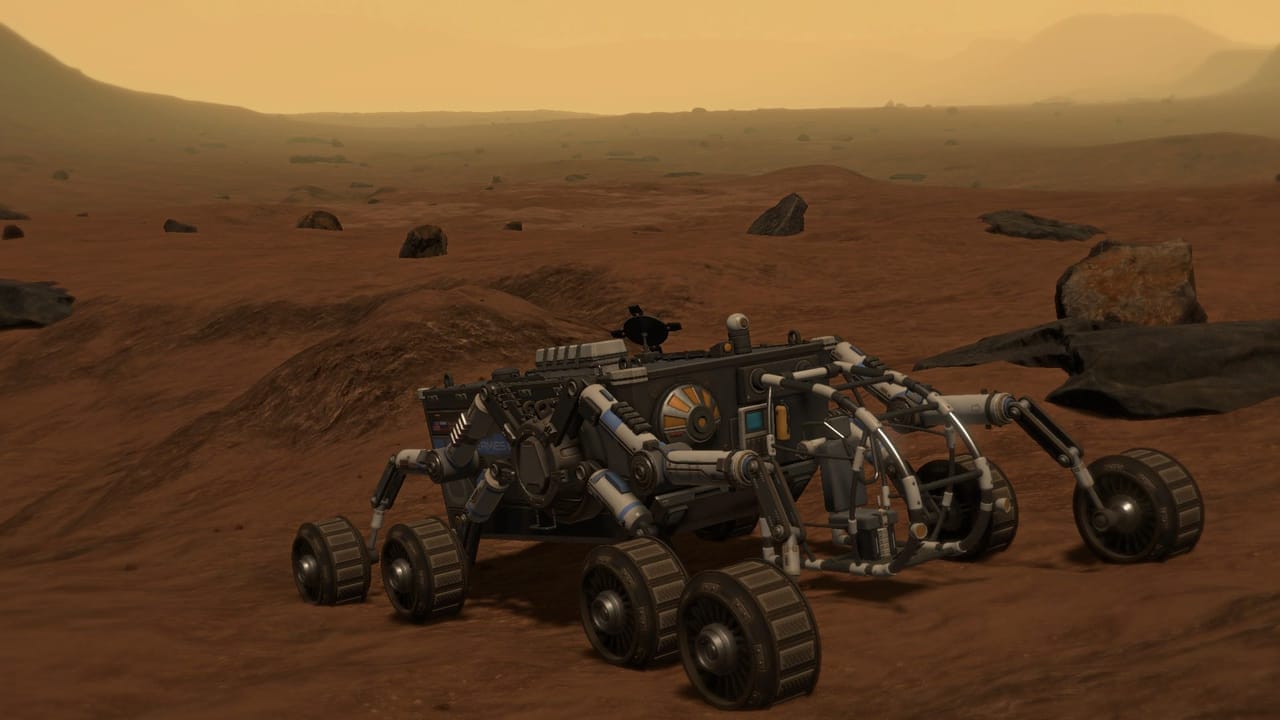
Lacuna Passage's Story Mode
TR: And so it stands to reason that that follows in other areas [of Lacuna Passage] as well. Okay, interesting. All we have right now in the pre-release build is the Sandbox mode which I played way more than I'm comfortable admitting. But the story mode, aside from a trailer that was released around 2014, it seems to be [a bit of] a mystery overall. [We know] that essentially you're on a rescue mission and then in traditional space crisis fashion the rescue mission turns out to be a bit of a disaster as well and you crash on the planet. From what you're willing [to tell our readers], what can you tell us about the story mode and its general overarching [plot]?TO: I guess one of the things I'll say first off about the story mode is that we've definitely gone through some major revisions to our goals as a company and where we want to take the game. That's affected the progress we've made over the last few years. The story mode is absolutely my personal white whale. It will get accomplished, this will be in the final game when we [exit Early Access]. Over the last few years, we've seen [a big focus on] these Early Access titles where you get to be a part of the development and shape where it's gonna go. I really, really wanted to jump onto that because I realized with such a small team I can only do so much as far as determining the direction that the game's gonna go. Some of my initial ideas ended up being things that players really didn't like or didn't care for and I had to figure that out as we went. I'm really excited to get people into the game and playing it. The story mode is going to be the culmination of everything we learn the Survival Sandbox on Early Access. As you mentioned, you're gonna be the [only] surviving member of the second manned mission to Mars. It was a two-phase mission where the first group would land a few days before the second and on the way there your team learns that contact is lost with the first group that was supposed to have landed before you. And so your mission has now changed from one of just standard, you know, "Go and research Mars and create a semi-permanent little colony" [to] investigating what happened to that first group. [Unfortunately], your mission crash lands and you're the only survivor. [Everything] is set out against you: you've got no support, you've got no communication, [everyone] who was there before you is apparently gone, you don't know what's going on, and so you're kind of alone trying to figure that out. [That's] the ultimate goal of the game and that's absolutely what our selling point will be on our full release. But for Early Access, we've really gone a long ways towards expanding on the original Survival mechanics that we wanted to include. I always knew that the Story mode would be supported by this underlying survival structure which a lot of other games in the same kind of genre [don't have] like Gone Home or Dear Esther [or What Remains of Edith Finch] - I really wanted there to be some true, more traditional game mechanics that add a level of urgency to that storytelling. As we started developing the story mode demos and previews, I realized that I wanted those survival mechanics to be more in-depth and so that's why we transitioned to the Early Access model. [I think] that we're really gonna push a lot of really cool stuff in there like potentially interactive vehicles, having interactive greenhouses to grow food, and really build up that feeling of surviving on Mars while you're also discovering a really interesting story.
https://www.youtube.com/watch?v=-MpanoY1iB8
The Prologue Trailer for Lacuna Passage is from November 2014, so it's expected that some things have changed since then. Even so, the narrative that is being built here seems intriguing.
TR: I imagine that one way or another, the eventual Story Mode (when it's done), there's going to be a definitive end (whatever it might be). It could end in your death, it could end in you escaping Mars, it could end in the colony being successfully established—any number of things that I can't think of. That's only stuff that you really know and that might change by the time it all comes because stories evolve over time. But what about the Sandbox mode? Because unlike a lot of traditional Sandbox games, your resources are very limited, especially at the beginning. I didn't know—you said there [are going to be greenhouses just now]—but the first thing that immediately came to mind is unlike everything else in the game, food is finite. You're gonna run out of food, and you're gonna run out of supplies because fuses are going to blow and stuff like that. Eventually you're just gonna run out of stuff and die. Are there plans for a definitive end scenario or multiple end scenarios for Sandbox like "[Established a colony], yay, you win!" or "Escape from Mars, yay, you got away from this hellish red planet that Mark Watney hates"? Aside from dying, basically.
TO: Yeah, so, in the Survival Sandbox mode - at least to start, we're really stressing the sandbox aspect of that. The primary goal is literally just - if you want to have a goal for yourself- is literally just to survive as long as you can. In our development roadmap - we actually have a page on our site that you can look at to see what our development priorities are for the Survival Sandbox - and you'll see that we are adding in some secondary objective types like research. What I'd like to do in our earlier updates for the Early Access aspect would be include kind of a score screen that shows how well you did in the Survival Sandbox before you run out of resources and die. Right now, that would mostly include [how] long you survived but we want to do things like collecting geological research, documenting the different landmarks that you discover by taking photos of them, and other types of research activities that you could accomplish. That would add to your end score a bit basically. There's a bunch of different things we could do. As far as surviving until you get rescued or establish a colony, that's certainly something that we could look into based on the feedback of our players. If people want something that's a more transparent [end goal] I'd love to do something like that.
TR: I suppose one of the core reasons I ask [is that it's] the one [big] problem [most] survival games suffer from. [Once] you hit the maximum ceiling, they really tend to just run out of steam at the end. Well, what do you do? But there's potential for some really really clear [goals]. When I say [something like] establishing a colony, I don't mean like having NPCs or other players, I mean like, "Okay, you're there, you got everything back online, now they can send other people. But basically you've got it all set up and you just have to wait until Sol 125 and just keep yourself alive until then[.] Then a supply ship comes[,] more people join you[,] and that's the end of the game, mission accomplished. Or "mission is scrubbed", so you need to get this escape rocket thing back online like at the end of The Martian - do all the modifications, track down all the parts, then stick your butt into it, launch up into orbit, and you escape and humanity will try again at some point in the future. I just think maybe because of it being the whole of Mars and how the mission can go wrong - that's really where it came from. I feel like - I wouldn't necessarily say that open-ended, never-ending survival wouldn't work but... you kind of know where I'm going with [this], right?
TO: Yeah. And I think what you're kind of referencing is what I have in mind for the story mode. Having clear goals that have a narrative backdrop is definitely what we want to do for the Story mode. And without saying too much about it because obviously it's a little ways off yet, [what] I would love to do is have multiple possible ways that the story mode could end. I want to give the player some choice rather than having them just unravel a very linear, static story. But I think that those things will be in there for people who want them but there's also the potential for different ways for them to "solve" the problem. But, for the Survival Sandbox mode I think one of the problems you get into when you start outlining explicit end goals is that people quickly figure out the path of least resistance to those goals. And so you end up with basically a finish line that people will figure out the [fastest and easiest] way to get there and once they've done that, what do they have to come back to improve upon? There's nothing left for them to conquer. For the Sandbox mode - like I said, stressing the Sandbox - creating an environment where there's a decent level of randomization and requiring the player to think on their feet and solve problems continually just to try to improve upon their previous best is what we'd really like to do for the Survival Sandbox mode and then provide those more static goals for the Story Mode.
TR: You answered a good chunk of my next question in that - how would the Story mode and Sandbox mode differ? But [what I'd have to ask] that you didn't cover, are you going to be playing the same character in both scenarios or [are you going to be] playing Generic Filler Person in Sandbox and the proper Story character in Jessica Rainer in Story Mode? How's that gonna work?
TO: A while back we were discussing what context you would be in for the Survival Sandbox mode. Granted, as it is now and at launch there's not a whole lot of context to ground you in what the scenario actually is. Again, it's our Sandbox, right? You're kind of playing with the tools that will make up the Story mode. Right now, you're technically playing as the same character. We don't have any distinction between them for what the Story mode will be. One of the things [we've] talked about a little bit is having a narrative context for the Survival Sandbox where it [would be a] training simulator of some sort where [Jessica Rainer, the main character from the Story mode] would be playing through a fictional kind of challenge simulator where she'd have to survive on Mars with randomized elements. If we wanted to fit it into some kind of narrative context that would probably be what we'd do but for now [there's not] really much of a context outside of exploring the toolset that we're creating for the Story mode.
TR: On the bug reports forum where I threw a wall of text at you guys-
TO: [laughs] Sure.
TR: I feel a little bit bad about that...
TO: No, no!
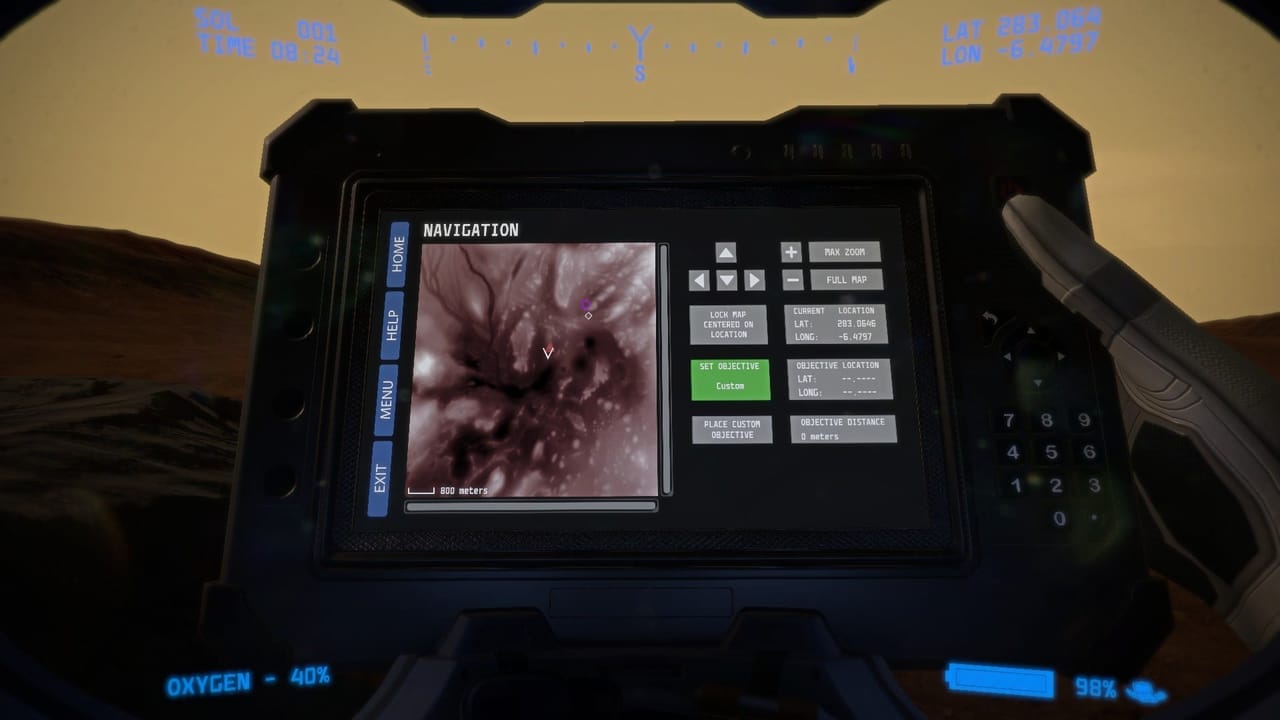
Lacuna Passage's Sandbox Mode
TR: I tend to have problems with being concise as evidenced by me talking so much so far. [laughs] But I digress, on the bug reports forum, you said there was something like nine different maps for Sandbox mode? How did you come up with those maps?TO: I'm not sure exactly what I said on the feedback forum, but right now there's one giant map for the Survival Sandbox mode that's roughly 25 square miles but we've highly randomized the components that make up the map as far as the types of things you'll be discovering and the locations where you can spawn so that it feels like a new map every time you play. There are nine possible Habitat spawn locations and for each time you play the game three of those Habitats will spawn and they'll spawn in such a way so that it kind of creates a journey across the map for you. So every playthrough creates this unique path through the same map that you'll probably not explore the same way twice.
TR: Ah, you know what? I just looked it up. You say, "there's a total of 9 possible spawn locations" but that was ambiguous because I [thought it could be either] nine possible maps or... it could be read either way.
TO: Right, yeah.
TR: So the Sandbox always takes place on the same section of Mars but everything gets rearranged in a total of nine different ways basically?
TO: It's actually way more ways than that, but yes. The nine [possible locations for Habitats] and then [the three of those] can be in a bunch of different configurations. And then each Habitat has two possible locations where you could be dropped in the drop pod. So there's like hundreds and hundreds of different ways that you could be arranged in that map. And even if the three Habitats spawned in the same locations on one of your several playthroughs, all of the different discoverable supply caches and rovers, those are also randomized for each playthrough. You might remember where something was at in a previous playthrough and go there and it's not there anymore. You really have to rely more on your tools like your Scanner than just knowledge of previous playthroughs.
TR: To be fair, it's a big red desert. I'd be really impressed [if someone said,] "Oh, that's the hill where the satellite is". It all looks like a red, featureless desert to me with occasional blips of, "Oh look, a building where I'm not gonna die, thank god".
TO: [laughs] Yep, yep.
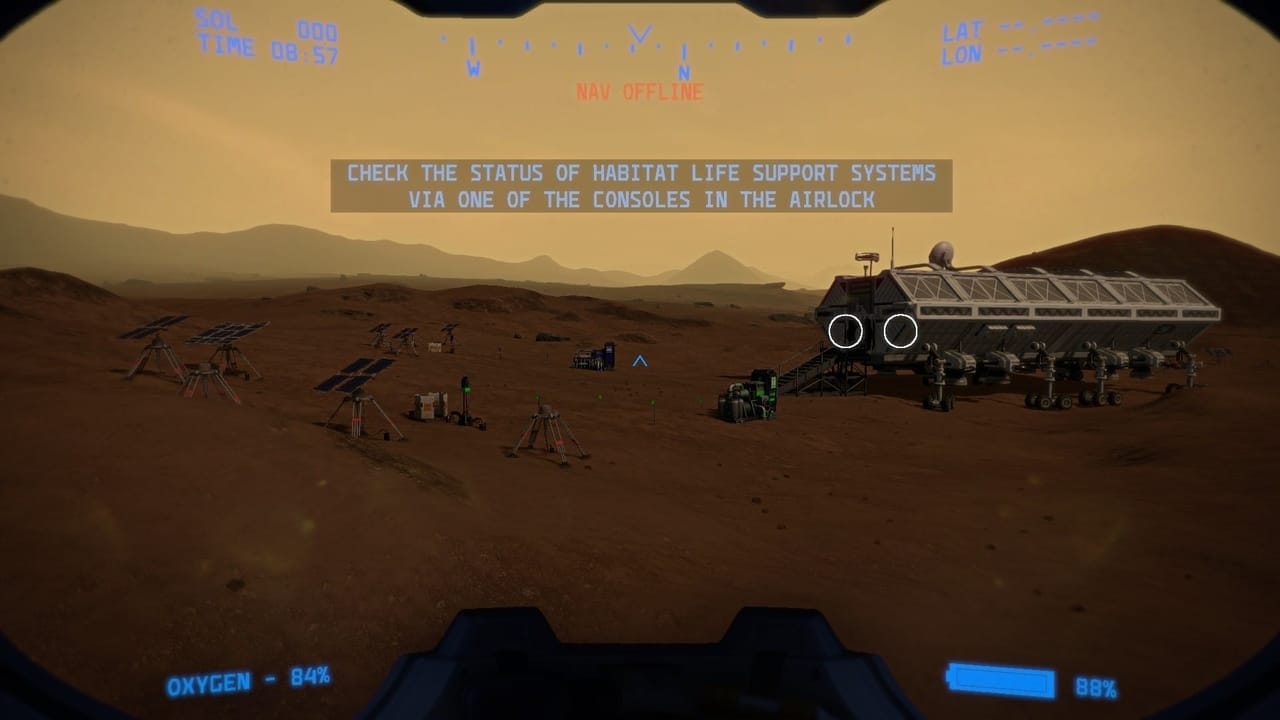
The Habitats
TR: I got some questions about the Hab itself now specifically. The Habs, looking at them - they have wheels and what looks like downward-facing thrusters on them. At a glance, just guessing, I would guess that they were airdropped, used the thrusters to slow down as they approached the surface, and then were towed into place by a rover (which we saw in the Alpha trailer from 2014 or something like that) and that would explain why they were set up where they were set up. Do I have the right picture there or is it something else?TO: Yeah, you've pretty much got it. Those thrusters are purely for descent and settling [the Habs] down onto the surface and the wheels - it's not a powered vehicle or anything, so those were just to get it into position and have it rest on those for settling it into place.
TR: And so I'm guessing that the door on the opposite side - [it's like] a trailer on a tractor-trailer and the door the opposite side would be if you were in the [towing vehicle] and you [needed] to get into the Hab. Rather than having to walk all the way around, you would just go into that door.
TO: The best thing with a lot of space engineering is that everything is designed to be kind of mix and match and inter-connected. You've got that mostly correct. We are also planning for the potential to have expanded sections on the Habitat that would connect to that currently unused back door.
TR: In terms of the Hab, why did you decide to give each system - the Water Reclaimer, the Electrical, the Heater, and the Reoxygenator - why did you decide to give each of them their own independent array of power generation rather than just having a centralized bank of solar cells and RTG mounts?
TO: So from a design perspective when it relates to the actual engineering of how a real space mission would go I don't [know if] they would go that route. There is a level of redundancy to it where we have each life support system have its own power source and components. But I think from a gameplay perspective it provides an interesting choice for the player especially when you get to kind of the end game of the Survival Sandbox where you're really running out of supplies and maybe you don't even have enough working Solar Panels left to power all of your different modules. I like the gameplay choice that the player has to make in management of resources where you'd have to potentially go out every day and swap solar panels between different life support modules in order to keep your supplies up. Produce oxygen during the day with solar panels and perhaps produce heat at night while you're inside the Habitat with the reserve batteries from the Electrical module. There's a bunch of different ways that you could manage that and I kind of wanted to leave that up to the player to decide how they want to manage their life support modules rather than just doing it for them.
TR: Okay. Yet another Hab question: they seem to be kitted out with all the necessities for life on Mars. There's a restroom, bunks for six people (more if they hot rack), plenty of storage... and I also noticed... this might sound really dumb, but I just now noticed that [on] the roadmap you can scroll to the right. Now I see there [a Fitness Station and a Research Station] so these are all the things you were talking about potentially being added [in] later. What I'm most curious about and [what doesn't seem to have an obvious purpose] - what is the I.R.A. (Intelligent Remote Assistant)?
TO: That is something that we originally developed as part of our Story mode and [is still] planned to be in the Story mode. It's kind of our homage to the HAL 9000 and these other similar A.I. assistants from science fiction and space travel. He is not your stereotypical... he's more of a really advanced Apple iPhone Siri. It's something for Jessica to converse with and have additional dialogue in the Story mode. To have someone there that she can talk to, even if he's not very smart, to expand on the narrative of the game. [We hope to turn him into something of a tutorial] option so that you could ask him questions about what certain things do rather than just reading it off of your data pad.
TR: That answered that. So basically, [I.R.A. is] the thing that's gonna try [to] lock me in the airlock and murder me while saying, "I'm sorry, I can't open the pod bay doors, [Jessica]."
TO: [laughs] Well, I hope that we subvert that expectation in player's minds. There's certainly a lot that can be done with the character.
TR: [I'm] thinking about the sea of sci-fi history I've seen over all of the years... 2001: A Space Odyssey, Star Trek, and Star Wars... I would actually think that a computer in a space mission that didn't try to kill you probably would be a subversion.
TO: [laughs] Yeah, yeah. I hope that people will see that when we have the Story mode out.
TR: I think even if you explicitly went and said, "This [thing will not attempt] to ever kill you," people will be like, "Look dude, I read Asimov. It's gonna try to kill me at some point. It's gonna re-interpret its programming to be like, 'If I kill them, it doesn't mean they die so it doesn't break the three laws.'"
TO: [laughs]
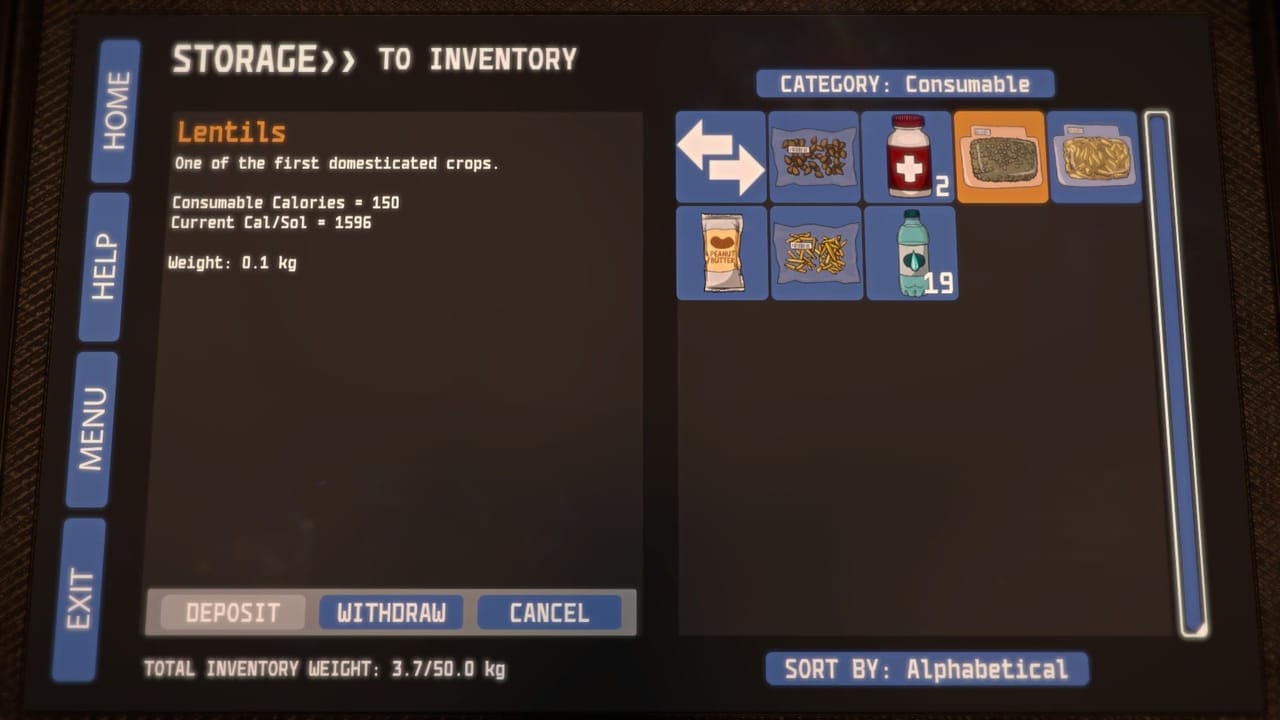
EVA Suit
TR: Okay, so, I like a lot of what you've done in terms of the technology and the redundancy [of components]. Any kind of space mission, they tend to be really, really hardcore about having redundancies and versatility and you've reflected a lot of that in the design of the modules [and the] computer systems. [One] thing I'm really curious about (and I have seen some players complain [about this] on the bug tracker): why don't the EVA suits have any way to consume food or drink water while you're enclosed in them? Now, before you respond, I [did some research on this. I initially thought there was no way they would have food inside an EVA suit, but] I actually found that in the ISS (International Space Station) NASA spacewalkers used to actually be equipped with a little snack bar on their shoulder.TO: That's right.
TR: So if they got hungry, they could kind of angle their neck down and munch on it. [But they] stopped using it because it was such a pain in the butt that they decided [to eat before doing an EVA]. The core thing: why no water inside an EVA suit? 'cause that seems to be the more limiting factor to me than anything else [when] I'm out and about walking on Mars.
TO: A lot of what we're doing with the Early Access version is getting this great feedback from players to see what it is that they really want. And then as a developer, you always have to balance what a player wants with what you think is best for the game and what creates a challenge versus what just creates frustration. I wanted to start out with not being able to consume water or food while you're in your EVA suit. Food being more accurate since there currently isn't really any real-life way to consume food while in an EVA suit. But the water one, I just wanted to see what kind of challenge that presented players and whether or [they] liked or didn't like that aspect. Coming up with a balance there I think is gonna be important over the whole course of our Survival Sandbox mode. I'm planning on testing that feature soon [and I think] that would come down to a preference on the player's part. But usability-wise, I think that lends a lot to the survival and simulation realism.
TR: [In my research, I found that NASA has either a 32. fl. oz. or 20 fl. oz. tank in an EVA suit.] Which sounds like a lot, but if you're walking around for literally an entire day, well... you're not gonna get ridiculously dehydrated but you're not gonna be able to be out there forever. Another curiosity I've noticed about the EVA suits is that they have a compass on them. Well, they have a bearing indicator but that's just about as good as a compass. Now, Mars doesn't have a strong enough magnetic field [and so a magnetic compass wouldn't work], so how exactly [do the compasses in the EVA suits work]? Do you have a technological explanation or a story justification for that or is that just a handwave for player usability?
TO: A little bit of both. It's one of those things that I think has a big benefit for the player as a [frame of reference] for positioning. 'cause like you said, there's really not a ton of in the way of recognizable landmarks to go off in the barren wasteland of Mars so having some kind of compass heading from a player usability standpoint is pretty important. But from an explanation standpoint, [one of] the things that we are utilizing for navigation in the game are these things called Waypoint Stations or WayStats for short. They're kind of a combination of a navigation tool and a weather monitoring station (and they may have additional features in the future). We're kind of going off of the assumption that some level of compass heading could be feasible with sorts of triangulation technology or point-to-point reference as far as your rotation in a three-dimensional space. There's all kinds of technologies that I'm sure NASA or other companies looking to explore Mars could use to solve that problem.
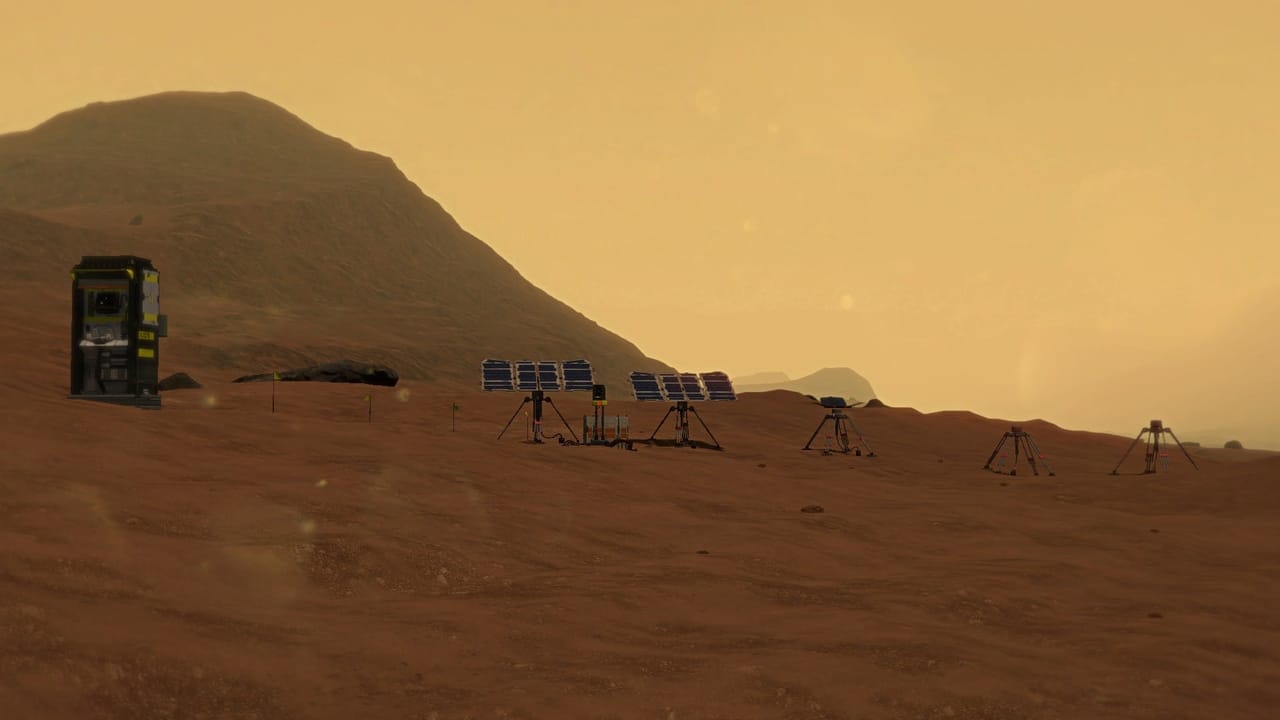
Weighing The Science vs The Gameplay
TR: I wanted to hear your answer before telling you that [NASA already sort of solved] this problem with I believe, funnily enough, the Curiosity rover. With a satellite up in orbit, they were able to use that communicating with the rover to kind of make [an] ad-hoc GPS system. It is a totally doable thing. Overall, you've done a lot of [research about what Mars is like] but that was something that really stood out to me. It'd be like two suns in the sky in a game set on Earth, but that seems like a good explanation.TO: Yeah, it's one of those things where... for our frame of reference here on Earth, we use magnetism to handle the compass headings but there's all kinds of other ways you could do it. You taught me something with the explanation for how the Curiosity rover does it. There's multiple different ways to solve the same problem and people who work for NASA and these space exploration companies - they're pretty [intelligent] people.
TR: Regarding the WayStats, [one of the other things] that really stood out to me was the way the radio signals worked. I noticed that you have four different icons in the game: a purple circle for Habs, a white diamond for points of interest, a blue square for containers, and a red triangle for Waypoint Stations. But there's no unique identifier label and there's no distance available for those. Is that a deliberate choice or is that not in the game yet? I found that to be one of the most confusing games about navigation. In terms of the physics, I'd be hard-pressed to explain it to you [properly and in detail] but the short of it is that because radio [waves moves] at the speed of light and it's a constant, if you're getting a radio signal from A to B and you're talking back and forth between a radio in your suit and a radio in the thing you're heading towards you should be able to calculate the distance [based on how long it takes between pings]. Distance should be a thing you should be able to see there, and as for a unique label like "[WayStat 27]" or something like that, that should also be something that should be able to carried easily enough as a data transmission between two points in such a short range. So since both of these things are possible, my question would be: are they not in the game yet or is it a design decision not to have those in yet or something else?
TO: I would say it's 10% design decision and 90% a combination of not done yet or trying to figure out exactly how I want to do it. There are some features in the game that I think are just simply a little bit different than what players might be used to for a survival or exploration type game like this. One of them is our photography feature. I don't know how much you spent time with that at all.
TR: I used it to mark certain containers or points of interest so I could make a waypoint to them later which I'm pretty sure is one of the intended features. But I did [that as an end-run] around the lack of [unique labels for points of interest and distance indicators]. I distinctly recall in one of my earliest playthrough sessions that I found a [supply cache] but I was already [nearly at full carrying capacity]. [I wanted to go back to that so I took a picture to make a waypoint.]
TO: This is the kind of great stuff that I love to hear from players to see what their experiences were in playing. I hope to get more [feedback like this from] our Early Access players. The photography feature is something where I wanted players to create more of a connection with the things they discovered by documenting their discoveries through photos and being able to mark those positions on your map by selecting the photo from your photo app [is one] of the ways I wanted to do that so that you have an actual gameplay reason for taking photos. Getting a semse for what players want, how they want to accomplish their goals throughout the Survival Sandbox mode, that's gonna be a big part of what we're looking at for the first few months of our Early Access and really tweaking things here and there to see what works best.
TR: So, technologically I think we could both agree [that it's] a thing that can be done. But gameplay-wise, that's where the decision really has to be made and [how] it would be implemented.
TO: And how to implement it into the user interface in a way that feels natural. For you, if selecting the photo from your photo app and selecting the waypoint - if that's too many steps to go through for some players or if it's not intuitive, that's something we have to fix. Maybe if we had the ability to just select the icon from the map and have that then show up as an objective. [You can set a custom waypoint anywhere on the map right now.] If the user interface isn't intuitive enough for people to figure that out then yeah, that's something we gotta fix.
TR: That's something else I also did. [I would see an objective on the Scanner but I wasn't close enough for it to show up on my map so I would estimate where it would be and place a custom waypoint there as a guide.] It worked more or less. I was a Boy Scout and we did this thing called Orienteering. For the reader's sake, that's [basically,] "Here's a map, here's a compass, you're here, we're going here, try not to get lost you idiots." And it felt a lot like that: look at the map, [look at the Scanner]; a lot of bouncing between menus and trying to find [what I was looking for] until I would get line of sight on it. Zoom function on the EVA suit, very helpful for that. Next question: I wouldn't be able to look at [Lacuna Passage] as a whole without saying [that you've done a lot of research about what's involved with a mission to Mars]. In terms of Mars, you got a lot of stuff right like the slightly longer day. [Another physics-related thing I'm curious about:] Mars has lower gravity[, approximately 0.4G]. Just as a gut feeling [from my time on low gravity servers in other first-person games,] it doesn't feel like you're in 0.4G. Is that something that's going to be tweaked or adjusted later? [I'm just curious] about why so much other stuff about Mars seems to line up but one of the core things about being on Mars itself really doesn't.
TO: It's interesting that you bring that up. It's not something that I've had many other players mention. There's a lot of complexity that goes into figuring out what that would actually feel like since we don't have really great ways to replicate what that would feel like on Earth other than going up in a parabolic flight where they can recreate different levels of gravity or even zero G. One of the things with the types of equipment that you're carrying is that because the gravity is lower it means that the human body is able to carry heavier equipment and it feels like it's not as heavy as it actually is. In reality, I don't think even as an astronaut on Mars [with these] giant heavy EVA suits you'd really be able to jump as high as you think you might be able to. So I guess in that regard I'm trying to be a little more realistic in regards to the height that you can go. But the accuracy of the acceleration during falling I believe is pretty accurate as it stands right now. The physics are all handled in-game according to the real-life gravity values for the planet. Again, that comes up as one of those questions: do we keep it more realistic or do we go with what the player feels? I think a good example is in other games, everything is usually way bigger than it would be in real life because that's just what feels right in a first person perspective. So doors are much higher than they should be or the handle on the door is like in the middle of the door because that feels right even though [on a real door it would be towards the bottom.] It's little things like that where you have to figure out, "Well, does this feel right? Even if it is accurate, does it feel right for the player?" Yeah obviously, that's something that we'll have to take into account as we do more testing.
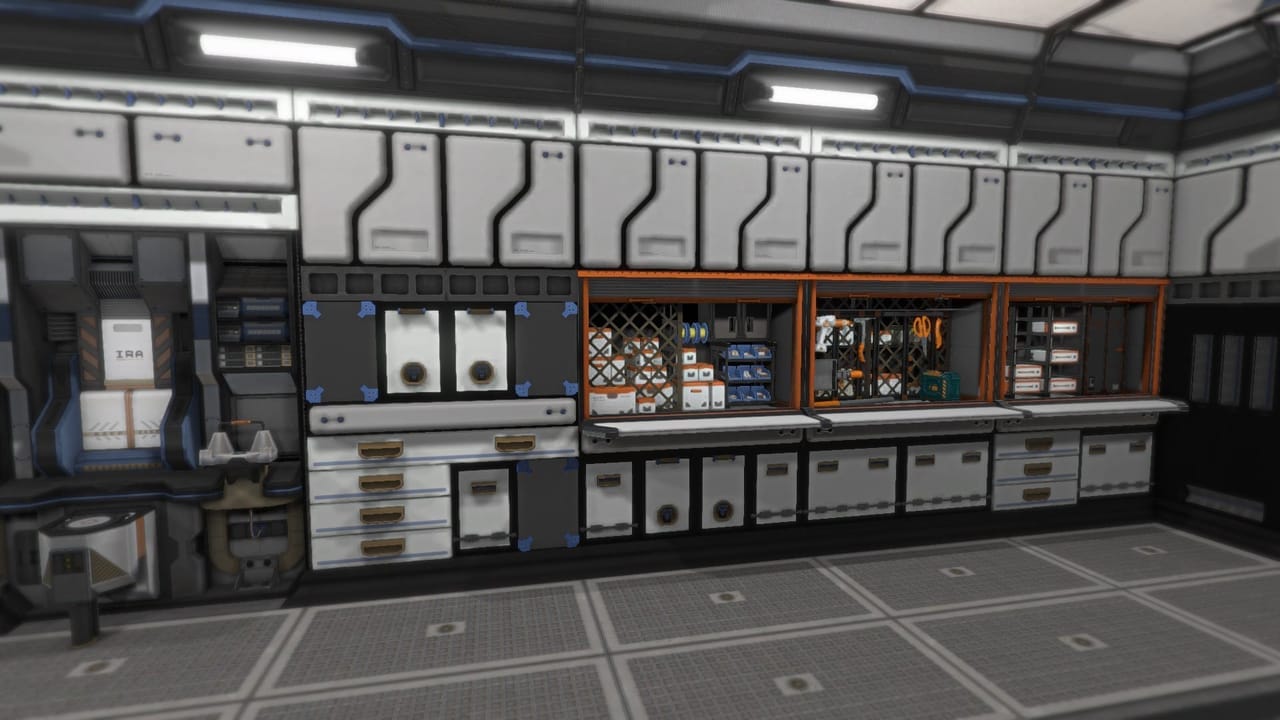
TR: It's clearly something that you've thought about from your answer. [I was in the middle of re-reading The Martian for the fifth time when I played Lacuna Passage and there was] a line in the book where Mark Watney said the fastest way to move on Mars was skipping. Just because regular running locomotion wouldn't work [as well] with the reduced gravity even considering the heavier EVA suits. I guess probably where other players might have not had that knowledge in their head and I did - going in, knowing that, [it didn't feel right. I suppose I thought it would look a bit like the footage from the moon missions, even though Mars' gravity is a little stronger than the Moon's].
TO: There's all kinds of things we could adjust [depending on if] we discover that this either feels better for the player or is more accurate to reality. As long as it fits the gameplay, I'd love to implement it. In that case, I think it's one of those things where... yeah, like you said, if we put in a running animation that looked like you were skipping I think a lot of players would be like, "What the heck is going on? Why am I skipping on Mars?" I know that that's definitely the case for the Moon and I'm sure if Andy Weir says that's the faster way on Mars, I'm sure he's done more research than I have. I'll take his word for it.
TR: Yeah, [Andy Weir is a little bit hardcore]. He wrote his own programs to calculate orbital mechanics.
TO: [laughs] Yup, yup.
TR: Moving on, the missions that you're on - is this a NASA or a government-sanctioned mission or is it a private endeavor? With NASA, usually you find their logo - if you have a spacesuit, there's like [18 frickin' NASA logos on it]. Same thing with private companies, they like to plaster [their logos] everywhere. The only indication that I was able to notice [was] a drill rover I came across out in the wild had a U.S. flag, a U.K. flag, and a Russian Federation flag on it. But other than, there wasn't really any notable branding or clues. Now I'd understand not having any NASA [logos or branding] on there because that's protected by federal laws; you can't just slap NASA on there and get away with it, you'll totally get like double sued. So I guess it's kind of a two part question: is this a private mission or is it a government mission, and why the lack of [logos]?
TO: For the purposes of the Survival Sandbox we're kind of eschewing any references to the entity that provided the mission equipment. That is something that we'll absolutely get into more details in the Story mode eventually. I think the primary driver for the fictional missions in the game will be a private company.
TR: [Why aren't the locations of somewhat static objects like the Habitats and Waypoint Stations available on your initial map? It's understandable that things like crashed satellites would not show up, but I would think that a rescue mission would have been equipped with this information from the get-go as the first wave would probably report the locations of these things as they set them up. However, it's also possible that some of the things may have been moved after contact with the first mission was lost.]
TO: What you were just saying kind of comes into effect. That would be the explanation essentially for why you're not aware of the positions of a bunch of this equipment. It would come down to where the first crew installed things. When you're planning for a mission you can make assumptions about where would be a good place to install a piece of permanent hardware but once you get there it might be a totally different matter and you have to make things up as you go. For the Story Mode, absolutely, that would be the explanation. But if we do end up creating a narrative context for the Survival Sandbox mode, it kind of goes back to what I was saying earlier about how this would be essentially like an after-hours challenge simulation for the astronauts where it would not be at all accurate to real mission conditions. It would be more bragging rights for the astronauts-in-training to see how far they could survive in this sandbox simulation.
TR: Alright, that's reasonable. Aside from the Habs and the WayStats, are players going to have any other support infrastructure available to them such as communications with Earth, access to satellites, anything like that?
TO: There's all kinds of things we'd like to prototype and throw into the Survival Sandbox. One of the things that I'll be looking at early on is creating a system for calling in supply drops. There would be follow-up missions, unmanned probes and satellites that would be able to drop supplies in. As a player, you'd have to set up a drop location by using some kind of equipment to mark the landing zone. So that's something that I'll definitely be looking at incorporating. I'd love to do driveable vehicles. I'd love to have [(as I mentioned earlier)] expandable units that could be added on to the back of the habitats and I think that's what we'd like to do for the greenhouses eventually. That would be where they would be connected. There's all kinds of things that we could do. As always, our goal is to follow as close as possible what would be in a true Mars mission and from there it just goes into what would make for a compelling gameplay scenario and interactive elements.
TR: Overall, the picture I'm getting is [that] you're trying to be more accurate [than not,] but you're also willing to make compromises for the sake of gameplay and user-friendliness.
TO: Absolutely, yeah.
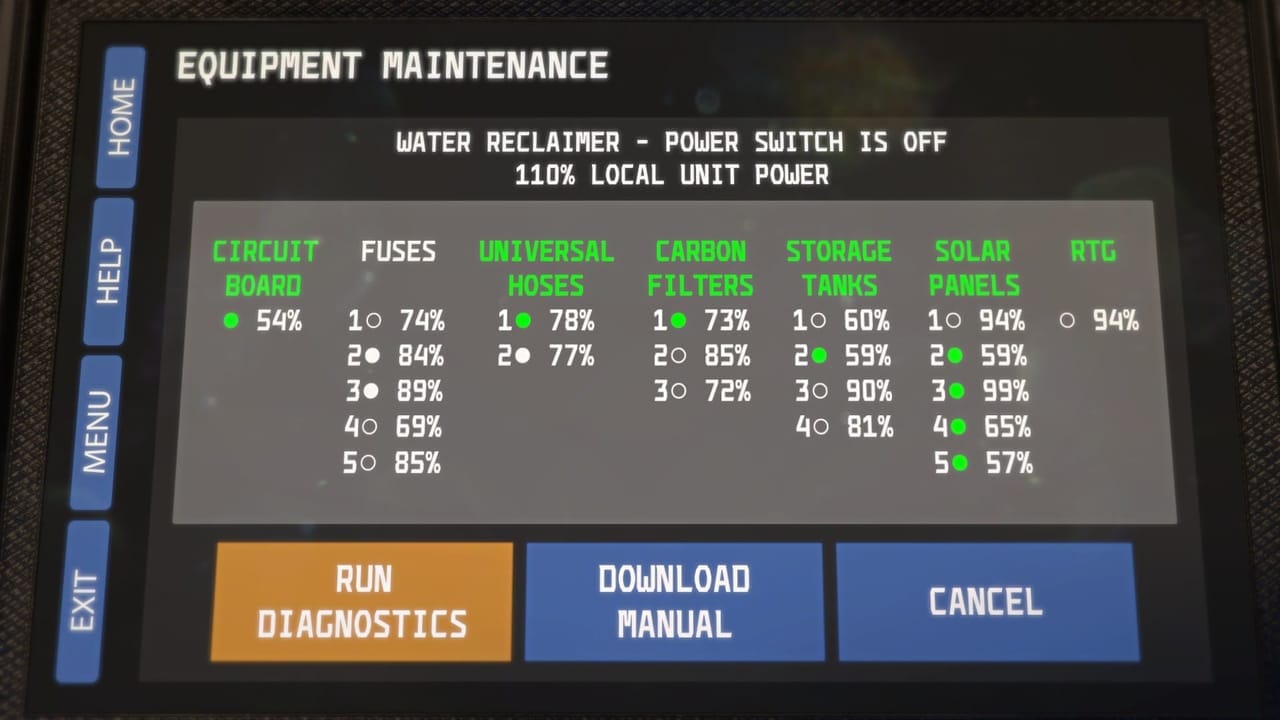
Release Date and Platforms
TR: On to the last few [questions]. When do you think the [Story mode] is gonna be ready to go and complete for Lacuna Passage?TO: I'll probably just have to use the standard dev response and say "When it's ready". I think part of the great thing about Early Access (and some people would say [it's a detriment]) - I really, really value the feedback that we get from our players. A lot of development priorities are gonna be decided based on the feedback we get from players. I don't want to give any firm ideas of when a Story mode might be complete because for all I know people are gonna love the Survival Sandbox mode and they wanna have us just keep adding to that for a significant portion of our development resources. Yeah, that's about as good as I could say it. It is my ultimate goal to complete that Story mode and I won't stop until it's done so it's definitely a priority for me.
TR: And the follow-up to that: is the Story planned to be released all in one go? Are we gonna have a gradual episodic release?
TO: It wouldn't be viable for us to do the episodic aspect just because I want it to be non-linear in structure. It would be as a final release [and when we exit Early Access.] It's actually pretty similar to the development process that The Long Dark is using. We're kind of using them as a model. I really like their development team and the way they communicate with their players. They've been working on a Story mode for a long time that I think is gonna be great.
TR: Yeah, it's supposed to come out in August I think. That actually is honest-to-goodness the impetus for me asking. I thought, "Oh, the Story mode will just be done and it will come out," and [they decided to go with an episodic model]. It doesn't necessarily seem like that crazy of a thing [for Lacuna Passage to have an episodic story when The Long Dark] is also very sandbox-y and open-ended. I don't think it's entirely out of the [question.] Moving on, which platforms are you going to be targeting for Lacuna Passage aside from PC which it's already on?
TO: We'll be on PC and Mac at launch. I'd love to get us on Linux if possible. I've got a list of testers who are gonna be helping me out with figuring out if that'll be viable for us. I'd love to get it working there. There's also the possibility of VR if it works out. I know for some first-person games it can be difficult to accomplish just 'cause of the different types of traversal methods - making them fit in with everything else, all the other interaction options you have in the game. Yeah I'd love to experiment with that as well.
TR: Are you going to shoot for consoles at all?
TO: Not right now. I think that it's really difficult for a team of our size to comfortably manage a multiplatform launch for consoles. If it's within our resources after our initial launch, then yeah I'd love to be there eventually, but I can't say anything for sure right now.
TR: And just for clarity's sake, when you say "initial launch" [do] you mean after [Lacuna Passage] gets out of Early Access and the Story's done?
TO: Oh sorry, yeah. Our Early Access launch will be Mac & PC, and then after that if it becomes viable to port to other platforms we'd certainly look into it.
TR: Roughly how much do you think Lacuna Passage is going to be retailing for?
TO: On Early Access we'll be launching at $14.99 and after that I haven't really decided what the value of our game going into the future will be because a lot of that will depend on the updates that we made to the game. It's possible it could raise in price in the future. But at launch, on Early Access, it will be $14.99.
TR: Final question: is there anything else you'd like to get out there to our readers?
TO: Well one thing we didn't mention a whole lot today is the terrain aspect in the game is something that I'd love for our space enthusiasts out there to know [about]. All of our terrain in the game is actually pulled directly from scans of NASA satellite footage from the terrain on Mars. It's about as accurate as you're gonna get to at least the forms and shapes that the features of Mars has. I think for a space enthusiast it's really cool to be able to be walking around the game and see something and realize that that is a feature directly pulled from Mars. It's really cool for me as a fan of space exploration to be able to walk around on what is about as close to the real Mars as you can get.
TR: Thank you for your time.

Normally, I don't speak to an interview subject much beforehand save for the initial contact. In this case, I had a good degree of back-and-forth with Tyler Owen on the game's bug tracker forums after I reported a handful of issues I encountered during my first playthrough (as well as subsequent playthroughs). Based on my interactions there alone, I saw a developer who was communicative and worked hard to fix whatever was broken.
It always baffled me that no one had tried to tackle the "Survive on Mars" (or any other world, really) experience and all of the challenges a player would face. So many survival games have some kind of NPC or other players as the adversary, but in this game an entire planet is your adversary. The air is unbreathable, the temperatures are bitterly cold, and supplies are running dangerously low. It's a nice break from crafting a bolt-action rifle to headshot zombies for the eight-hundredth time. Lacuna Passage is positively a breath of fresh air compared to most of the other survival stuff out there.
I'm anxious to see how the story of this game plays out. I rather enjoyed what I've played of The Long Dark, and I think Lacuna Passage will be able to deliver a similarly excellent experience in terms of pitting the player against a harsh environment. And much like its wintery Canadian brother, I am anxiously looking forward to the Story Mode. I don't know what secrets and mysteries Jessica Rainier will unravel throughout her journey ... but I can't wait to find out. If you'd like to see what this game has to offer, head on over to the game's Steam page.
What do you think of Lacuna Passage? Do you prefer survival games with enemies to fight, a harsh environment to overcome, or both? Do you think survival games should lean towards realism or should they simplify things more for the sake of gameplay? Let us know in the comments below!
Have a tip, or want to point out something we missed? Leave a Comment or e-mail us at tips@techraptor.net
